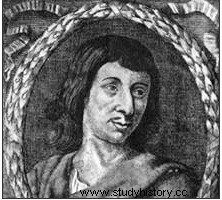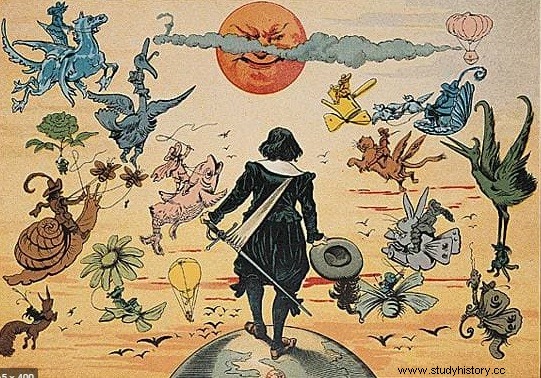 Cyrano de Bergerac , the theatrical hero really existed, but the imaginary character is more alive and more believable in the mind of the public than the original man. Far from the character portrayed by Edmond Rostand in his famous play, the real Cyrano de Bergerac was a writer, rebellious and libertine. Parisian and not of Gascon origin, passionate about science and philosophy, he was the author of several plays and a novel of anticipation, Histoire comique containing the States and Empires of the Moon (1657 ). In the latter, he describes future inventions such as the phonograph or the stage rocket.
Cyrano de Bergerac , the theatrical hero really existed, but the imaginary character is more alive and more believable in the mind of the public than the original man. Far from the character portrayed by Edmond Rostand in his famous play, the real Cyrano de Bergerac was a writer, rebellious and libertine. Parisian and not of Gascon origin, passionate about science and philosophy, he was the author of several plays and a novel of anticipation, Histoire comique containing the States and Empires of the Moon (1657 ). In the latter, he describes future inventions such as the phonograph or the stage rocket.
The real Cyrano de Bergerac
Savinien de Cyrano de Bergerac et de Manières was born in Paris in the 2nd arrondissement (current district of Les Halles) in March 1619. "De Bergerac" and "De Manières" come from fiefdoms that the family held in the Chevreuse valley. Savinien has four brothers and one sister. His grandfather was a sea fish merchant for the King. His father Abel de Cyrano was a squire in 1636. Savinien spent a childhood in the countryside and kept the name of Bergerac in order to enter the Cadets de Gascogne more easily.
In 1631, Savinien returned to Paris to study at the Collège de Clermont. Not pursuing higher education, he enlisted as an infantryman with the Cadets de Gascogne, under Louis XIII. Curious attitude since it is the opposite of his character:perhaps he had no more food? maybe he had a run-in with the law? Although he is a skilful shooter, his war wounds are numerous (musket shots, sword blows). He participated in the Fronde, first against the Bourbons, then he supported Mazarin even if Savinien was resistant to all authority. Both came from the Jesuits, the cardinal recognizes in Savinien an original spirit. A soldier during the Thirty Years' War against the Spaniards, he then served Louis XIV.
Returning from the armies in 1641, he did not seek to obtain an office, he lodged with his father and again became a student at the College of Lisieux; he takes dance lessons and is registered with a fencing master for two years, the fees of which are paid by his father.
A private life with little information
His private life and love affairs are virtually unknown:he drank spiritual rather than earthly foods, drank water, frequented not taverns but bookstores, including spending her little money, rather than on nice clothes (untidy, no wigs, long hair). His childhood friend Henri Le Bret does not give details about his physique, so we will not know more about his "nose". Some engravings show an appendix without being extravagant, some scars and a face of character.
During this period, he met Gassendi (science), Chapelle (literature) and Campanella (philosopher). It is a curious assemblage of friends, attracted to each other, yet Savinien is in no way effeminate, he is a solid fellow, tough as nails, but with great sensitivity on edge; in love often hurt, passionate, never married and having no children. In 1648, his parents being no longer in this world, he received a small nest egg allowing him to complete his tragedy "the death of Agrippina".
In 1649, he wrote "mazarinades", then published a letter against the Frondeurs; he moved to the left bank of Paris and devoted himself solely to writing, to walks in the parks, which he recounted in his letters "against Winter" or "of the aqueduct or the fountain of Arcueil" . Money becoming scarce, he did not always have enough to eat and ended up agreeing to have a rich protector in the person of the Duke of Arpajon, Peer of the kingdom, lieutenant general of the royal armies. Lodging in the ducal palace, the lodging and the cover are assured to him. The duke had the "Mort d'Agrippine" published at his own expense, but Savinien was fired because of the libertine tone he used in his tragedy.
In 1654, shortly before his death, Savinien confessed his weariness of crossing swords, preferring the oratory contests of the Latin Quarter. He suffers an accident that will be fatal to him. A dangerous head injury left him bedridden for many months with a high fever, with his cousin Pierre II de Cyrano where he died in July 1655. His friend Le Bret speaks of a piece of wood received on his head:attack? crime ? everything is possible, since at the Hôtel d'Arpajon, strange events had occurred (fire and carriage attack). No investigation is carried out, no official writing is published, there is only the testimony of the priest "who died as a good Christian". His death is an unsolved enigma.
The character of Cyrano de Bergerac
According to his childhood friend, Savinien had "a sharp tongue" but had a passion for study, reading, writing and freedom. spend. Reluctant to discipline, he skipped school, walking in the forest, listening to birdsong and various noises, bathing in ponds as he will tell in his novels. Lover, epicurean philosopher, well-read, scholar in science and letters, inventor of science fiction literature, original, misunderstood in his time, he has a great thirst for freedom, refusing the established order and expressing his revolt with humor.
An "obligated" believer with rebellious ideas, while being rather skeptical in matters of religion, we often find his hostility to patriarchy, to the head of the family as in his comedy "the Pedant played”. Advancing in age, he fiercely defends the Greek and Latin texts, not tolerating any jokes on this subject. He has knowledge and skills in all areas.
His writings and legend
Many personalities are favorable to Cyrano "he is a terrible writer" with his private or published letters, commissioned texts, science fiction novels. And although there are the "libertine works of Cyrano de Bergerac" published at the beginning of the 20th century, his work contains very few ribald or erotic texts.
 Following his walks, Savinien wrote two novels "the States and Empires of the Moon" and "the States and Empires of the Sun”. These are works popular with academics, telling the mysteries of the human condition on other planets, rebelling against received ideas here below, imagining extraterrestrial life as a natural evidence, a beautiful mixture where trees and animals reason, nature being a nurturing mother, as Montaigne had already written a few decades earlier. These two texts will really inspire Hergé, Jules Verne, Orson Welles.
Following his walks, Savinien wrote two novels "the States and Empires of the Moon" and "the States and Empires of the Sun”. These are works popular with academics, telling the mysteries of the human condition on other planets, rebelling against received ideas here below, imagining extraterrestrial life as a natural evidence, a beautiful mixture where trees and animals reason, nature being a nurturing mother, as Montaigne had already written a few decades earlier. These two texts will really inspire Hergé, Jules Verne, Orson Welles.
Savinien is also the author of a tragedy "the death of Agrippina", written in 1647-1648, performed only once a few years later, dealing with the triple story of love:a masterpiece of the classical language. Finally, his comedy "le Pédant Joué", written in 1645-1646, performed in 1654, without success, is based on a real event at the Collège de Beauvais whose main character is the director of the school. The comedy could not be printed because of "religious irreverence", Cyrano mocking the Catholic mass. Savinien is dead, Cyrano is born.
Cyrano de Bergerac was born thanks to Edmond Rostand. The first performance took place in December 1897:40 encores, an hour of applause, cries of joy and spectators who refused to leave the room. A real success. Since then, a multitude of actors want to play the role of Cyrano, despite errors of date or situation and despite the criticisms published in newspapers such as the "Mercure de France" considering that this comedy is "the art of bad writing". …
To go further
- Cyrano of Paris. The Bergerac Mystery, by Yonnick Flot. La Bisquine, 2018
